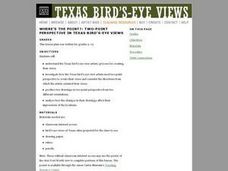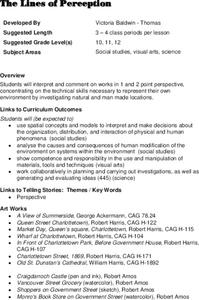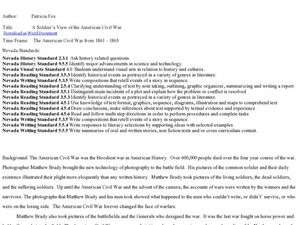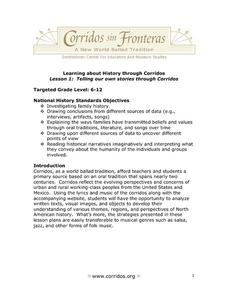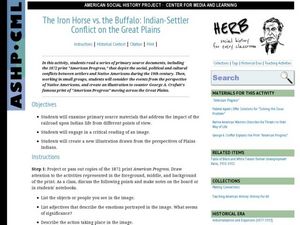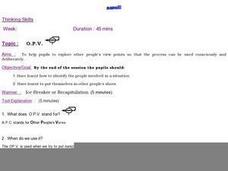Curated OER
Where's the Point?: Two-Point Perspective in Texas Bird's-Eye Views
Learners investigate how the Texas bird's-eye-view artists used two-point perspective to create their aerial views and consider the directions from which the artists oriented their views. They produce two drawings in tow-point perspective.
Ford's Theatre
How Perspective Shapes Understanding of History
The Boston Massacre may be an iconic event in American history, but perhaps the British soldiers had another point of view. Using primary sources, including reports from Boston newspapers and secondary sources from the British...
Curated OER
The Lines of Perception
Young scholars interpret and comment on works in 1 and 2 point perspective. They locate the focal point of works done in 1 point perspective and create a drawing of a street or landscape in their local area using 1 point perspective.
Curated OER
Point of View
A picture is used to begin considering point of view. Then, have kids role play included scenes which all involve some type of conflict where the character's have very different perspective. Discussions ensue each role play, with kids...
Curated OER
The assassination of the Archduke: Exploring Perspectives
Use political cartoons for a multiple-perspectives strategy, as pupils learn about the assassination of Archduke Franz Ferdinand. After an anticipatory discussion, they are split into 2 groups. The class reads a primary source account...
Curated OER
Lessons in Looking: Contraband in Paintings
Using the paintings On to Liberty and A Ride for Liberty, 10th graders analyze historical perspectives on life after the Civil War. They attempt to determine what the Civil War meant for free slaves, then read a paragraph highlighting...
Curated OER
About Life: The Photographs of Dorothea Lange Going to the Promised Land
To better understand the migrant experience during the Great Depression, pupils analyze two primary resources: photographs by Dorothea Lange and a U.S. Map that shows the Dust Bowl. They compare and contrast Lange's images to Steinbeck's...
Curated OER
Call It a Hunch
Give young scholars a chance to practice making inferences after reading the book Through My Eyes by Ruby Bridges. They confirm whether or not their conclusions are true, have a class discussion, and then independently complete an...
Curated OER
A Soldier's View of the American Civil War
Study and research the American Civil War in this explanatory writing lesson. Middle schoolers complete six activities to learn about the American Civil War and soldiers' views of the war. The lesson includes several options to complete...
Curated OER
Thanksgiving: Multiple Perspectives
Students examine different perspectives about Thanksgiving that include those of the European Settlers and the Native Americans. They read and discuss an article about Plymouth being "America's Hometown." They develop a landmark for...
Curated OER
From Whose Perspective?
Young scholars critically analyze news coverage of Palestinian-Israeli violence by comparing information from a variety of news sources. They compose expository essays reflecting on how to obtain accurate, unbiased, and credible...
Curated OER
Historical Fiction: A Wealth of Interpretations
Students read a book from the Dear America series and contrast different points of view. They respond to the book either by participating in a literature circle or completing a journal entry. They compare and contrast two books or a...
National History Day
“War Is Hell. We Know it Now.” American Soldiers in the Meuse-Argonne Offensive
Understanding the soldier's experiences during World War I sometimes takes a newscast. Learners see the importance of understanding multiple points of view with a newscast project surrounding the Meuse-Argonne Offensive. Compare and...
Curated OER
Primary History: What Happened to the Anglo Saxons?
In this world history learning exercise, students investigate, "What happened to the Anglo Saxons?" They examine Anglo Saxon influence on language and place names. They describe the Norman invasion from two points of view and find...
Curated OER
Passing Down Family History Through Oral Tradition: Corridos
Learners create and perform Corridos which are oral tradition ballads. In this Passing Down Family History Through Oral Tradition lesson plan, students interview family members using a predetermined list of questions. In addition,...
Curated OER
Four Armed Men From the Renaissance!
Students study the Renaissance and the important art from the period. In this Renaissance lesson, students discuss the black plague and religion during the Renaissance. Students read the Renaissance worksheet and learn vocabulary words...
Curated OER
The Iron Horse vs. the Buffalo: Indian-Settler Conflict on the Great Plains
The Iron Horse encroached upon the land while conflicts escalated between Native Americans and the settlers. Sophomores study the print, American Progress then discuss how American progress affected Native Americans. They will study the...
Curated OER
Tools of the Historian: Frame of Reference
Students discuss the term point of reference and describe their own point of view. They compare the relationship between sources and the historical context. They identify examples of how point of reference can affect one's interpretation.
Curated OER
O.P.V. (Other People's Views)
Pupils explore other people's view points so that the process can be used consciously and deliberately. They identify the people involved in a situation. Students put themselves in other people's shoes.
Curated OER
Talking Heads
Young scholars create an imaginary conversation. In this perseverance lesson, students complete a t-chart about words that describe perseverance and words that describe the opposite of perseverance. Young scholars sketch a "talking...
San Bernardino Co. Supt. of Schools
Was Julius Caesar a Good Leader for Rome?
Learners consider the various perspectives that different groups in Roman society may have had for Julius Caesar, such as Roman soldiers, senators, the working class, and slaves. The primary activity involves a reading of Caesar's...
Curated OER
Exploring History Through Photographs
Fifth graders compare and contrast photographs from the 1800s to those of 2003. In groups, they create drawings of how society has changed over time and use maps to locate local streets. Individually, they practice measuring the...
Curated OER
Symbols of Canada
Sixth graders investigate the link between Canadian symbols and identity, offering various perspectives of what Canada means to Canadians. They explore the natural world around them and choose an image to sketch.
Curated OER
The Civil War
Students, examine The Civil War, from a variety of perspectives and assignments. After taking notes, they can choose from creating a front page newspaper article describing the fall of Fort Sumter, discuss the pros and cons of fighting,...
